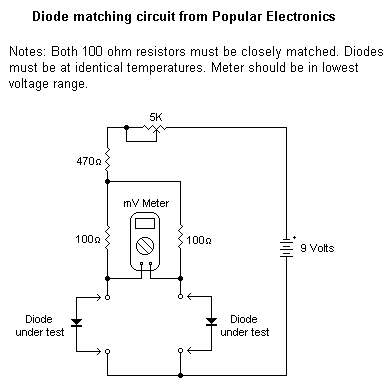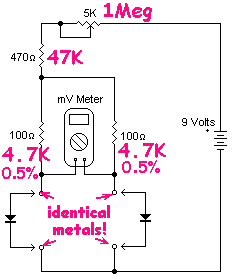>
I assume installing both diodes then compare voltages on each diode with VOM reading.
> Full rotation of the pot gives me +2 VDC (on one end) and +3 VDC (on the other end.
As I am ignorant here, what does this mean? What should I be looking for?
LOOK at the picture. There are two resistor-diode legs. There is a meter from diode to diode. What happens if all parts MATCH? The meter reads ZERO.
So if you find a zero-reading, the diodes match AT the current set by battery and resistors and some little stuff.
>
it might be nice to know test settings for certain types of diodes like 1N4153 etc...
THINK. What does the compressor DO with the diodes? There's several methods. Most run the diode from small or zero current up to a "high" current. The "high" current will be nowhere near the diode's rated current. 1mA to 10mA (maybe MUCH less) on common "100mA" diodes. Diode is diode. Nearly ANY diode can be used. You need to look/see what current range the COMPRESSOR is applying to the diodes.
If you have a good current meter, break the feed TO the diodes and insert current meter. Force the compressor from 1dB to 20dB gain reduction. Note currents. Now re-rig your first picture so the 9V, 5K, 470, and ~~0.5V diode drop cover the same range. More likely 100K audio plus 5K fixed. Maybe much higher. Put in your diodes, turn the pot, watch for least-difference over the whole current range.
33609 runs maybe zero to 23V through a couple K ohms, say from zero idle to 5mA-10mA MAXED-out. The network feeding the bridge is about 5K. So diode current of less than 30/5000 ma or 0.006mA is not important. And diode current 10 times higher is 20dB gain reduction, a LOT. I'm thinking the important range is say 0.01mA to 0.1mA.
We see that the PopElectronics diode tester is NOT scaled for audio compressor diode testing. What a shock.
With 9V battery and 0.5V diode, we want 8.5V/0.01mA to 8.5V/0.1mA, or 850K to 85K. Put a 1Meg pot in series with 47K.
The "100 ohm" test resistors probably should be more like bridge impedance, 5K.
We are looking at MILLI-VOLT errors. Thermocouple effects will exceed a milliVolt. Diode sockets (and leads) should all be identical metals and temperature.
Now insert diodes, turn the pot, watch the meter. Note if error is "small". If not, try another diode.
What is "small"? Diode bridge signal levels are near 60mV. If you turn the pot and diode difference is as bad as 50mV, and compressor time constant is rapid, the attack THUMP will blow your woofers. If diode voltage difference is 10 times less, 5mV, the thump will not be noticed on most program material. Golden-ears will want better than 5mV difference. 1mV difference is probably futile.... real-world drift will be this bad, that's just over-fussy and a time-sink. 2mV or 3mV is beauty.







